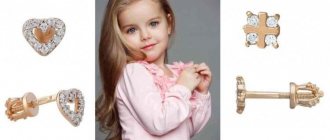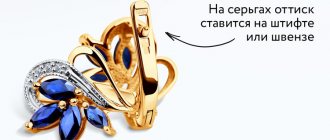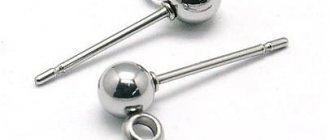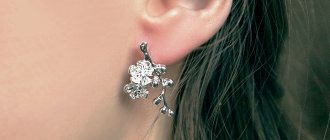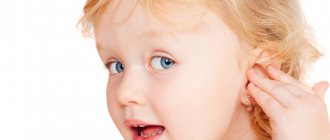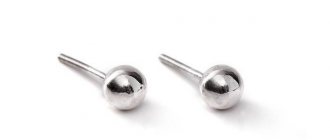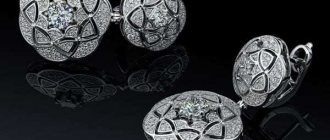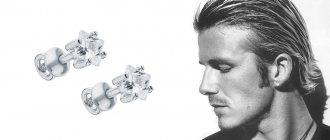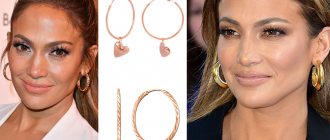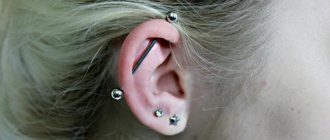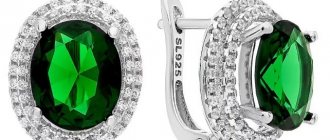Choosing the first earrings for a girl: all the subtleties and nuances
The daughter is an incredible creature who turns the strictest parent into a sweet “daddy.” It’s hard to refuse her and I want to give her the best. Beautiful dresses with ruffles, bows, hairpins, braids - we dress up our daughters, oh admiringly But what is a princess without beautiful jewelry?!
Choosing children's earrings is a real outlet for mothers. Together with their child, they can plunge into the bright world of childhood, remember their favorite toys and fairy tales. Children's jewelry is a special subcategory of jewelry where every detail is important. Therefore, the purchase of your first jewelry must be approached with double scrupulousness, taking into account many factors. Comfort and safety come first, and beauty comes second. This is the only way your child’s acquaintance with the world of beauty will be painless and pleasant.
What are the ideal children's earrings? From what material and with what decor is it better to buy earrings? Which clasp will be most comfortable for your fidget? Read about this and more in the article by YUK.
Contraindications
Piercing is not recommended if your baby has the following deviations in the general somatic condition or developmental pathology:
- dermatitis (eczema, diathesis, rashes and other skin diseases);
- allergies, especially of unknown etiology, to metals;
- blood pathologies (special attention should be paid to blood clotting; if it is bad, refuse the procedure);
- visual impairment, hearing impairment;
- otitis, strabismus, temporary inflammatory processes of the mucous membrane.
- chronic diseases of internal organs (asthma, hepatitis, diabetes and others);
- HIV infection;
- heart defects;
- mental illness, epilepsy;
- keloid scars;
- period of teething;
- low immunity;
- general malaise (snot, lethargy).
In some conditions, parents need to choose a different time for piercing, for example, to cure an acute respiratory viral infection, or wait until a tooth erupts.
But other pathologies are a lifelong contraindication - these are blood diseases, diabetes, nervous excitability, immunodeficiencies and nickel allergies.
At what age is it best to get your ears pierced?
This question is a real dilemma for parents. Should I pierce my ears from birth, when the baby is not yet aware of it and, accordingly, tolerates the procedure more easily, or wait until he reaches a more conscious age?
Pediatricians do not give a definite answer and advise parents to listen to their child and his psycho-emotional state. For example, if a child is restless and whiny, then why bother him again.
Most experts agree that the optimal age for ear piercing is from 3 to 11 years, some put numbers at 2-8 years. In their opinion, during this period the girl undergoes the procedure more consciously. In addition, the ear of a child under 3 years of age is still actively growing, as cartilage tissue is being formed. This means that if a puncture occurs in the first year of life, there remains a risk that by the age of 10 asymmetry may appear.
Up to 1 year
According to statistics, almost a third of young mothers pierce their child’s ears from the first days of life, demonstrating to others that they are having a girl.
Pros. A child under one year old does not yet realize what is happening to him, and, accordingly, is not afraid of the procedure. Less whims and tears. And it’s easier to treat a puncture, because the child will not be able to run away from his mother.
Minuses. At this age, you cannot explain to a child that you cannot touch the ears after a piercing, and this greatly increases the risk of injury.
Healing will be faster if you get your ears pierced in the spring or summer, when you don't need to wear hats/sweaters.
From 1 to 3 years
The child already reacts to shiny objects and can choose what he likes.
Pros . At this age, it is easy to agree on something with children: it is easy to stop tears by buying something tasty or a new toy.
Minuses. Please note that after the puncture site you will have to treat it 2-3 times a day - the procedure is not pleasant, and the baby will probably be capricious.
Children at this age are fidgety, so experts have more than once encountered the fact that a puncture was only possible in one ear.
From 5 to 8 years
The most optimal age. Children can choose earrings on their own and treat the puncture site.
Pros. Healing is very fast, the cartilage in the ear has already formed, so children are not at risk of asymmetry. Children at this age can more easily tolerate pain if the cause is explained and attention is diverted.
Minuses. The child is more willful at this age and can express his dissatisfaction.
The first two months after the piercing, the earrings should be in the ears constantly!
After 8 years
The child considers himself to be an adult. He is willful, independent, stubborn and may not listen to you. The girl decides for herself whether she needs earrings at all and what kind she wants.
Pros. At this age, a child develops his own taste and style. Minuses. There is a risk of a keloid scar at the puncture site. If your child is actively involved in sports, it is better to postpone this idea.
Reviews from parents
Elena, 35 years old:
When we were one year old, we were given gold earrings for a girl with an English lock. But the master strongly did not recommend us to wear them, because... First the ear must heal. As a result, we spent 2 months wearing earrings made of medical alloy, and then we put on gold ones. Now the child is 9 years old. She wears both silver and gold. The holes in the ears never bothered us.
Diana, 28 years old:
Indeed, any earrings need to be tried on. We bought carnations for our 2-year-old child, but in the end we went to a workshop to shorten the pin because... he injured the skin. There were earrings with an English lock. So we also had to shorten the pin, because... the earring was dangling. Therefore, be sure to try on earrings so as not to pay for trips to the master.
Arina, 40 years old:
I'm lucky. I actually bought earrings for my 7-year-old daughter from a photo in an online jewelry store. I took earrings with a French castle with Mickey Mouse. Everything fit perfectly. The only thing is that the child takes them off before going to bed because they are uncomfortable to sleep with.
What material is best for children's earrings?
You shouldn't skimp on buying your first earrings. Budget jewelry can cause redness of the skin, or even worse, allergies. To make the wound heal faster, give preference to yellow gold earrings. They are characterized by the least allergenicity and excellent aesthetic characteristics.
Aurum 585 does not oxidize and does not darken when exposed to water/shampoos. Silver is also allowed, but when wearing it, watch the reaction of the child’s skin.
How the process works
Before going to a medical center or a piercing salon, your baby needs to understand and know the intricacies of the ear piercing process. This is necessary to monitor the correctness of the specialist’s manipulations, monitor the child’s safety, reduce the risk of infection, and get rid of fear. The puncture takes place in several stages:
- Visual inspection . The specialist identifies the presence of contraindications. The child’s ears, skin, eyes, and head must be clean, without scratches, wounds, or suppuration.
- Tool processing . A very important stage, it needs to be controlled in order to avoid complications with the ears, hole in the lobe later.
- Puncture with a gun, needle . It is done quickly, in the presence of adults. Earrings are inserted using an automatic device or manually.
- Checking the quality of the procedure . Pay attention to whether the punctures are symmetrical and whether the lock is tightly fastened. They can also make a hole unevenly in specialized centers, it all depends on the experience of the master.
- Consultation on wound care . Parents are often given a booklet with useful tips and instructions. You should definitely take the technician’s phone number for consultation in unforeseen circumstances.
Decoration size and weight
An equally important parameter is the size and weight of the product. Children's jewelry that is too heavy can be uncomfortable to wear and even cause injury.
The optimal weight of earrings is 2 grams (for both ears)!
They are light and not felt in the sock. The large weight of jewelry is a direct path to enlarging holes and pulling down the lobes. In addition, massive earrings in small children's ears look absurd and speak only of inflated parental ambitions.
The older and larger the child, the heavier and bulkier the jewelry can be.
Gold or silver?
Everyone will probably agree with the fact that children's earrings should be made of noble materials, gold or silver. It is believed that gold, the traditional yellow color, is a metal for older ladies. And such products cost a lot, especially if they are inlaid with stones.
Earrings for girls made of silver with enamel or stones often look more organic on small ears than gold. Funny designs with animals, flowers, stars or your favorite cartoon characters look beautiful and are much cheaper than gold models.
Silver earrings with enamel, SL (price on the link)
Silver has healing properties and does not cause allergic reactions; silver earrings inserted into newly pierced ears promote rapid healing. Most often, silver earrings for girls are neat miniature models, light in weight, and practically not felt on the ears. The girl will be pleased to wear such stylish jewelry and feel almost like an adult.
Earrings made of silver with enamel, SOKOLOV (price on the link)
Flight of fancy: design of earrings for children
The children's line of jewelry is in no way inferior to adults: personalized models, with flowers, with fairy-tale characters/animals, with one decorative insert or several.
Consider the appropriateness of the earring design to the child’s age!
It is unlikely that any 15-year-old girl will wear earrings in the form of bunnies or turtles; rather, she will opt for stylish models seen in photographs in a fashion magazine. And, conversely, heavy, intricate earrings will look ridiculous on a one-year-old child. Therefore, for a girl, matching the decoration design to her age plays an important role!
For older children, you can buy earrings with pendants made of stones; cubic zirconia and zirconium are most often used. The most popular decorations are in the shape of flowers, berries and animals.
If the girl is actively interested in jewelry, let her take part in choosing gold earrings. Some will prefer simple and comfortable congo earrings of small diameter, while others will like playful earrings in the shape of kittens. One girl will be delighted with gold earrings without inserts, sparkling only due to the “diamond cut” treatment, another will like models with red, green or blue stones.
How to treat ears
By observing the basic rules of hygiene of the wound in the lobe, mothers will be able to save their daughters from suppuration and complications after piercing. Instructions for caring for your ears are as follows:
- Do not remove or change earrings worn in the salon for 2 - 3 months , thereby avoiding injury to the wound.
- Treat the earlobe and earring with antiseptics three times daily . Use chlorhexidine, hydrogen peroxide. It is not recommended to smear with alcohol or streptocide . If the earlobe breaks out, quickly begin to treat it with Vishnevsky ointment and other means.
- When processing, rotate the nail along the axis . Make movements with the bow so that dirt does not stagnate inside the wound. Be sure to pull the entire surface of the earring out and wipe it. Wash your hands thoroughly before doing this.
- Do not remove the dried crust from the wound . It will disappear on its own.
- Pull your baby's hair up into a ponytail to avoid infection in her ears.
- Use medical glue to speed up wound healing.
- Avoid swimming in open water , getting dirt, soap, and cosmetics on your earring and earlobe.
- Limit your child's physical activity for 1 to 2 weeks after the procedure .
Sweating can negatively affect tissue regeneration. If dirt or dust gets in, the ear can become inflamed.
Caring for ear cartilage after piercing
If you don’t want your new piercing to heal for a long time and painfully, give your ear proper care, following all the specialist’s recommendations. The process itself is not quick and can take several months.
Many people have helix piercings even though they may not realize it. Many individuals refer to their helix piercing as “my ligament piercing,” and the range referred to is the top of the ear. It's exceptionally easy to see someone have their ear cartilage pierced and maybe a couple different piercings showing up high on the ear. This is not a “ligament piercing,” as such a variety of people are happy to report.
Calling a helix piercing a ligament piercing is a misnomer, in light of the fact that your entire ear is made of ligament. Any piercing that is not contained to your ear cartilage is a ligament piercing. Tragically for some people, it was apparently pierced in a shopping mall through a penetrating weapon. Obviously, you will actually need a barbell, and your piercer may believe that this is an acceptable choice for you, so do what you are comfortable with.
Adhere to the following rules:
do not remove the earring for at least a month after it has been put on; do not let the wound get wet in the first few days, postpone swimming in a pool or pond, postpone a visit to an intensive shower, bathhouse, sauna; A special antiseptic will help relieve pain and prevent tissue swelling after a puncture in the cartilage, but do not confuse it with alcohol, which will burn the wound; when treating the ear with a solution, make sure that the composition washes not only the wound, but also the channel itself, to do this, scroll the earring in the hole; if you have worked hard in sports or physical labor, additionally treat the operation site, clearing it of sweat and dirt; and the most important rule is that in order to get yourself a fashionable piercing, contact only trusted professionals who have sterile instruments on hand.
The main true benefit of a band or ring is that it is better for swelling, and ring-pierced slots and loops tend to mend quicker, but to each his own! You will sit on the piercing site, which often resembles a dental professional's seat, and your piercer will make a seal on your ear. You have the chance to take the gander to the seal and approve or subject the subject to the area, once the area is populated, your piercer will push the needle through the ear as you exhale.
Decorations for all intents and purposes are quickly built in, and once the ball has been secured, your stunning new piercing is complete! This is an extremely safe puncture and the agony should only last for a short time. This penetration is a little confusing in light of the fact that the piercer needs to accurately measure the space between the piercings, however this should not be a problem for the expert. The most common types of eardrum repair procedures include myringoplasty, tympanoplasty, and ossiculoplasty. Recovery usually occurs after an eardrum repair procedure. Complications may occur, but they are rare.
This surgery can also be used to repair or replace the three tiny bones behind the eardrum.
To emphasize their individuality, girls get a beautiful ear cartilage piercing. Such decoration will please the eye and cause a minimum of hassle if the procedure is carried out by a professional in compliance with all safety rules. Before you pierce your cartilage with a needle or catheter, you need to know all about the risks. If you have already had an ear piercing or are just dreaming about it, then be sure to check out the latest information in our article.
The eardrum is a thin membrane between your outer ear and your middle ear, which vibrates when sound waves hit it. Repeated ear infections, surgery, or injury can cause damage to your eardrum or middle ear bones that need to be corrected with surgery. Damage to the eardrum or bones of the middle ear can lead to hearing loss and an increased risk of ear infections.
Try to prevent water from getting into your ear while you recover. Avoid swimming and wear a shower cap to drink water when you bathe. Don't "pop" the ears or nose. If you need to sneeze, do so with your mouth open to prevent pressure from building up in your ears.
When is it better to pierce your ears in winter, summer, spring or autumn?
An important aspect when getting your ears pierced is the time of year.
The procedure should not be carried out in winter, early spring and late autumn. When removing warm turtleneck sweaters from your baby, you can accidentally hit the ears, which should not be disturbed until they are completely healed. Summer time is also not suitable for ear piercing. Summer heat, dust, and playing in the sand increase the risk of unwanted particles getting into the hole, which can lead to a source of infection, as well as suppuration.
The most favorable period for ear piercing is late spring and early autumn. At this time, there is no longer any heat, but warm clothes are still a long way off; the baby wears light hats when going outside, so the risk of sand, dust and infection is unlikely, and the healing process can go faster.
Pros and cons of ear piercing using System 75
Advantages:
- rapidity
- absence of noise, unlike a regular “pistol”, which is important so as not to scare the child
- maximum sterility due to disposable cartridges
- the needle is very thin and specially sharpened, which ensures virtually no pain
- neither the earring nor the clasp come into contact with the reusable part of the device, which increases the level of sterility of the procedure
- the design of the device practically eliminates the risk of a mistake and does not require additional settings, since the earrings are already installed according to individual sizes in the cartridges as required
- there is the possibility of ear piercing at different times due to the fact that each earring is individually packaged in a sterile container
- needle earrings are made of medical hypoallergenic steel, titanium, bioflex
ear piercing with System 75
significant disadvantages , except that:
- the earring needle is ultra-thin, which means that at first you can only wear earrings with a thin bow
- the choice of first earrings here is also limited to those specially produced for System 75
- the likelihood of an automatic device malfunctioning or jamming is practically reduced to zero, but it still exists
Mechanism of action of COX 2 inhibitors (nimesulide, meloxicam)
During inflammation, the cyclooxygenase 2 isoform is formed; when taking a COX 2 inhibitor, it is quickly absorbed from the digestive tract, 89% of the active substance enters the blood. Once in the bloodstream, the drug replaces receptors that are receptors for COX 2, thus reducing the number of inflammatory markers (prostaglandins).
In addition to the blockade of these receptors, competitive replacement of COX 1 receptors also partially occurs, especially when taking drugs of this group for a long time or when the therapeutic dosage is exceeded.
A feature of this group is a decrease in selectivity with long-term use or use of the drug in large doses. Which accordingly increases the frequency of side effects, since under these conditions COX 1-dependent undesirable effects of drugs may occur.
Ear piercing for children using System 75
We are talking about new equipment from the American company STUDEX Co. USA. Professional ear piercing device SYSTEM 75 (System 75) is:
- disposable sterile cartridge with a pair of sterile containers with earring needles
- reusable tool
System 75
Immediately before the puncture:
- sterile containers with earrings are opened
- the cartridge with earrings-needles is installed on top of the instrument
- the device is brought to the ear with the sterile part - the cartridge
- puncture is carried out
- the earring is in the ear when closed
We prepare everything you need
Having understood the technique of how to pierce your ears at home, prepare everything you will need in the process. Find a pen or marker to mark the puncture site. You can replace writing utensils with a toothpick dipped in iodine. The last option will be the safest for your health. Find sterile cotton wool in your medicine cabinet, which you will need to treat your ears before and after piercing, as well as the needle itself you will use. Treatment is carried out with medical alcohol. In extreme cases, it can be replaced with alcohol tincture or vodka. Prepare hydrogen peroxide as well. Well, the most important thing is the needle. It should be of medium thickness, very even and preferably long, so that it is comfortable to hold in your hand and drive into the lobe.
